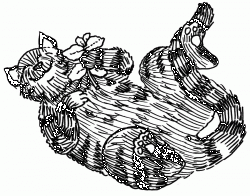Feline fix: Catnip helps Fluffy feel groovy, man
Q. Elephants have been known to gorge themselves on fermented fruits, parrots become more talkative after sipping alcoholic beverages, and one dog that lived near a brewery would often drink beer instead of eating. If your cat were inclined to take a "nip" every now and then, what might be its drug of choice? –J. Fariello
A. Catnip, naturally, an herb in the mint family and long famous for its appeal to cats, says Amanda O'Neill in Cat Biz. It contains the chemical nepetalactone, which makes many cats react as if intoxicated: They roll in the catnip, rub up against and chew the leaves. It has been described as "a non-addictive, legal recreational drug for cats," with the "high" lasting from a few minutes to an hour or more.
Not all cats are crazy about catnip, however, with some 20 percent of them lacking the receptive gene for it. It is also thought that the chemical mimics excitement pheromones appealing mostly to cats of reproductive age, leaving out kittens and elderly felines. Moreover, the herb can vary depending on growing conditions and thus will appeal to different cats. Overexposure to catnip reduces a cat's sensitivity, so for maximum effect offer it to Fluffy only at intervals of maybe every two or three weeks.
Q. When are diamonds not "a girl's best friend"? –M. Monroe
A. When they're "phony diamonds," artificial crystals of "cubic zirconia" that have a higher dispersion than diamonds, breaking white light into the colors of the rainbow, says Richard Muller in The Instant Physicist. Diamonds were once valued because of how they sparkle, cut in a complex way to send out many different colors in different directions.
Of course diamonds were once rare, making them expensive, so you would buy one as a present only for someone you truly loved (or wanted to impress). But now with cubic zirconia crystals, the colors are more beautiful for a cheaper price. So if you give one to a loved one, what does it prove? Intelligence? Good taste?
"Does it prove love if it's cheap?" Many people apparently think the price is more important than the beauty. So diamond jewelry is no longer expensive because it's beautiful, but "because the diamonds cost a lot." Diamonds are not really rare either, except to the extent that the diamond cartels try to keep them off the market to keep the price high.
A tipoff with a cubic zirconia is it's so much prettier that it's easy to tell it isn't a diamond. "Physicists are working hard to reduce the beauty of cubic zirconia stones so they will look more like the expensive ones," says Muller.
Q. Driving through a one-way tunnel, you suddenly realize a car is headed the wrong way– right at you! To minimize your risk from the impending collision, you should a) try to match your speed to the other car b) go even faster c) make a quick stop. –P. Diana
A. A head-on collision is the most dangerous type, so your best advice is to stop (c) and, if possible, put your car in reverse, says Jearl Walker in The Flying Circus of Physics. This way you can reduce the closing speed between the cars before any impact. The situation here is unlike football where one player may choose to speed up right before running head-on into another player.
"The difference is that the player may want the collision to be violent, and by properly orienting his body, he can shift the collision to his opponent's vulnerable area or cause him to become unbalanced and slam into the field," Walker writes.
Surprisingly, data show that, everything else being the same, an 80 kg (176 lb.) passenger in your car reduces your risk of fatality by nearly 10 percent because the additional mass lessens the sudden change in your body's acceleration and
velocity. That's your risk reduction; your passenger would be far better off spending the time at the movies.
~
Send Strange questions to brothers Bill and Rich at [email protected].
